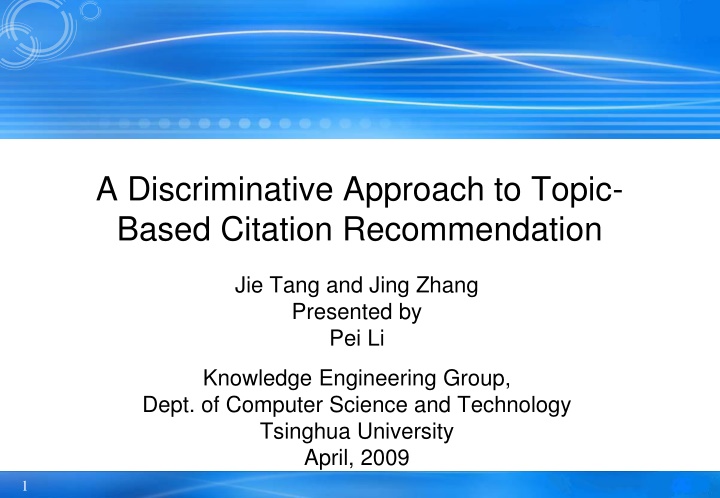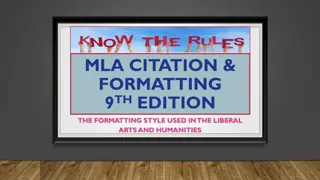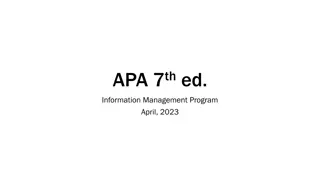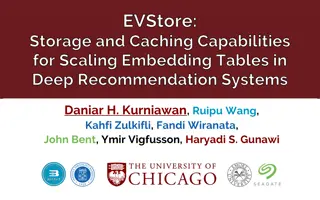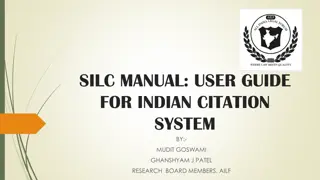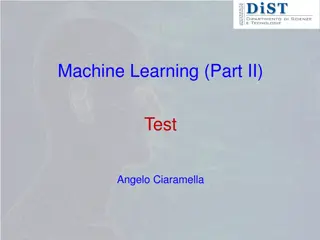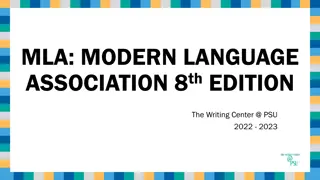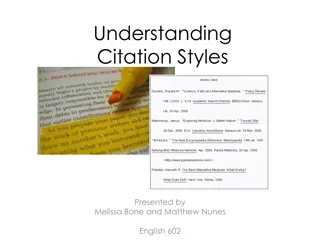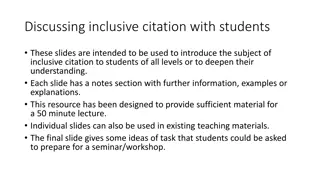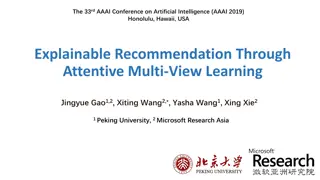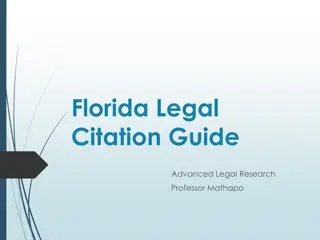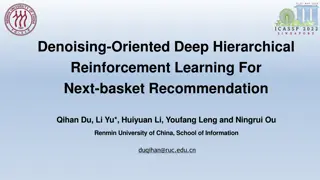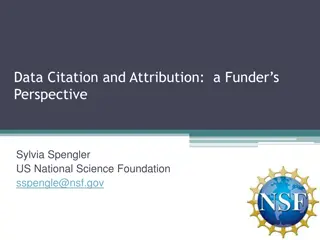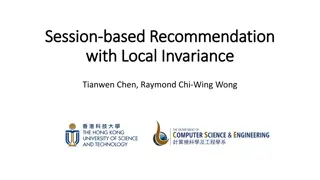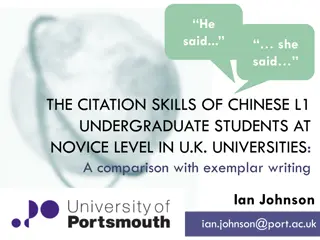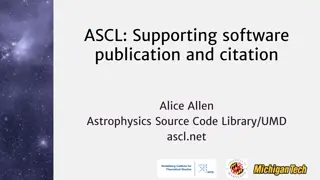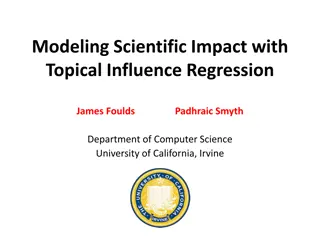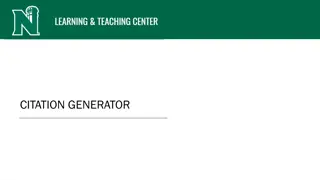Discriminative Approach to Topic-Based Citation Recommendation
This presentation focuses on a discriminative approach to citation recommendation, addressing challenges in academic search and text summarization. The RBM-CS model is introduced for ranking and matching recommended papers with sentences, showcasing experiments and conclusions. Prior work in measuring journal/paper quality and paper recommendation frameworks is also discussed.
Download Presentation

Please find below an Image/Link to download the presentation.
The content on the website is provided AS IS for your information and personal use only. It may not be sold, licensed, or shared on other websites without obtaining consent from the author.If you encounter any issues during the download, it is possible that the publisher has removed the file from their server.
You are allowed to download the files provided on this website for personal or commercial use, subject to the condition that they are used lawfully. All files are the property of their respective owners.
The content on the website is provided AS IS for your information and personal use only. It may not be sold, licensed, or shared on other websites without obtaining consent from the author.
E N D
Presentation Transcript
A Discriminative Approach to Topic- Based Citation Recommendation Jie Tang and Jing Zhang Presented by Pei Li Knowledge Engineering Group, Dept. of Computer Science and Technology Tsinghua University April, 2009 1
Motivation Academic search is insufficient in many practical applications 2
Examples Citation Suggestion Which papers should we refer to? ? Researcher A 3
Problem Formulation Query-focused Text Summarization We are considering the extraction-based text summarization. As for the models, we can adopt many existing probabilistic retrieval models such as the classic probabilistic retrieval models and the Kullback- Leibler (KL) divergence retrieval model. 4
Problem Formulation Query-focused Text Summarization We are considering the extraction-based text summarization. As for the models, we can adopt many existing probabilistic retrieval models such as the classic probabilistic retrieval models and the Kullback- Leibler (KL) divergence retrieval model. Two challenging questions: How to identify the topics? How to recommend citations based on the topics? 5
Outline Prior Work Our Approach The RBM-CS model Ranking and recommendation Matching recommended papers with sentences Experiments Conclusions 6
Prior Work Measuring the quality of journal/paper Science Citation Index (Garfield, Science 72) Bibliographical Coupling (BC) (Kessler, American Documentation 63) Paper recommendation using a graphical framework (Strohman et al. SIGIR 07) collaborative filtering (McNee et al. CSCW 02) Restricted Boltzmann Machines (RBMs) generative models based on latent variables to model an input distribution 7
Outline Prior Work Our Approach The RBM-CS model Ranking and recommendation Matching recommended papers with sentences Experiments Conclusions 8
Approach Overview RBM-CS Topic analysis with RBM-CS Discriminative model parameters Training data + U a M 1 b e Modeling Topic 1 Topic 2 Query-focused Text Summarization Test data: a new document We are considering the extraction-based text summarization. As for the models, we can adopt many existing probabilistic retrieval models such as the classic probabilistic retrieval models and the Kullback- Leibler (KL) divergence retrieval model. 2 1. We are considering the extraction-based text summarization. 2. As for the models, we can adopt many existing probabilistic retrieval models such as the classic probabilistic retrieval models 3 Citation set Matching 3. and the Kullback-Leibler (KL) divergence retrieval model. 2 Candidate selection 9
Modeling with RBM-CS model Discriminative objective function: L = = l w w log ( | ) log ( | p l ) L p d d j d d D d D = 1 j Bias terms Sigmoid func: (x) = 1/(1+exp(-x)) Bias terms 10
Ranking and Recommendation By applying the same modeling procedure to the citation context, we can obtain a topic representation {hc} of the citation context c. Therefore, we can calculate: T = + h ( | d p l ) ( ( ) ) U f h e c jk ck j = 1 k Finally, candidate papers are ranked according to p(ld|hc) and the topic ranked K papers are returned as the recommended papers. 12
Matching Recommended Papers with Citation Sentences The goal is to match 1. We are considering the extraction-based text summarization. 2. As for the models, we can adopt many existing probabilistic retrieval models such as the classic probabilistic retrieval models 3. and the Kullback-Leibler (KL) divergence retrieval model. Probabilities obtained from RBM-CS Use KL-divergence to measure the relevance between the recommended paper and the citation sentence: ( | ) | s T p h p h d = ( , ) ( | )log d k KL d s p h ci k ( ) = 1 k k ci the ith sentence in the citation context c 13
Outline Prior Work Our Approach The RBM-CS model Ranking and recommendation Matching recommended papers with sentences Experiments Conclusions 14
Experimental Setting Data Sets NIPS: 1,605 papers and 10,472 citations Citeseer: 3,335 papers and 32,558 citations Baseline methods Language model Restricted Boltzmann Machines (RBMs) Evaluation Measures P@1, P@3, P@5, P@10, Rprec, Bpref, MRR Parameter Setting K=7 for NIPS and K=11 for Citeseer Learning rate=0.01/batch-size, momentum=0.9, decay=0.001 15
Sentence-level Performance +7.65% +9.24% 18
Outline Prior Work Our Approach The RBM-CS model Ranking and recommendation Matching recommended papers with sentences Experiments Conclusions 19
Conclusion Formalize the problems of topic-based citation recommendation Propose a discriminative approach based on RBM-CS to solve this problem Experimental results show that the proposed RBM-CS can effectively improve the recommendation performance The citation recommendation is being integrated as a new feature into the our academic search system ArnetMiner (http://arnetminer.org). 20
Thanks! Q&A HP: http://keg.cs.tsinghua.edu.cn/persons/tj/ 21
